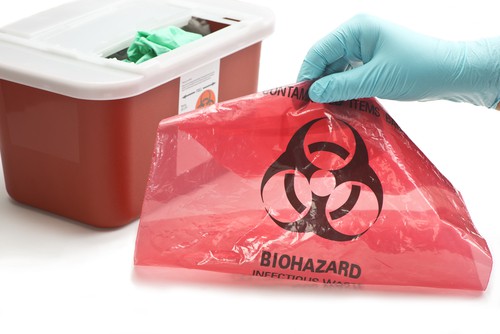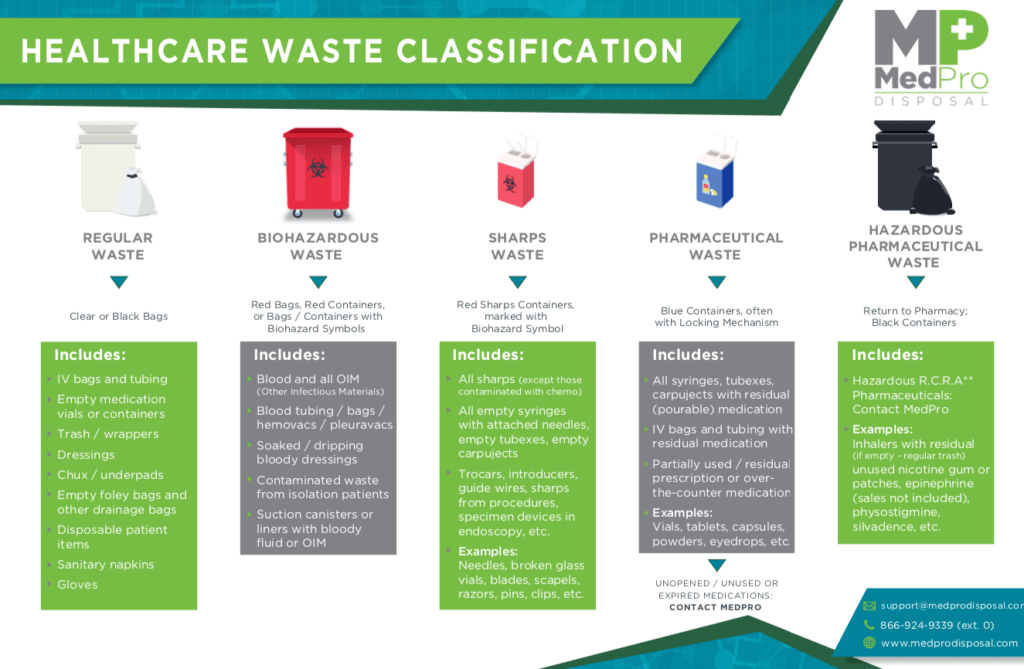Finest Practices for Medical Waste Administration
Medical waste administration is a critical aspect of healthcare centers' procedures to guarantee the safety and security of patients, personnel, and the atmosphere. Applying ideal techniques in medical waste management is important to lessen the risks associated with harmful waste. This consists of correct segregation and categorization of waste, ensuring its secure storage and labeling, sticking to regulatory standards, and using effective disposal approaches. By adhering to these finest techniques, healthcare facilities can decrease the potential for infections, injuries, and pollution triggered by inappropriate handling and disposal of medical waste. This intro aims to offer an overview of the value of finest techniques for medical waste administration and the subsequent areas will certainly look into each method thoroughly - medical waste disposal.

Segregation and Classification
In the field of medical waste management, proper partition and classification are crucial practices for making sure the efficient and secure disposal of healthcare-related materials. Medical waste is generated from various sources, including hospitals, facilities, research laboratories, and various other medical care centers. It is composed of a large range of things, such as needles, syringes, bandages, gloves, and pharmaceutical waste.
Segregation includes the systematic splitting up of different types of clinical waste based on their qualities and potential risks. Sharps waste, such as blades and needles, ought to be placed in puncture-resistant containers to prevent injuries and the spread of transmittable illness.
Categorization is the process of identifying clinical waste into different groups based on its prospective threats. These groups might include infectious waste, contaminated materials, pharmaceutical waste, and general waste. By classifying waste, health care facilities can identify the appropriate disposal approaches and make sure conformity with regional policies and standards.
Appropriate segregation and classification of clinical waste not just safeguard the health and wellness of healthcare workers and the public however additionally contribute to the overall efficiency and performance of waste management. It lowers the threat of mishaps, minimizes environmental impacts, and promotes liable waste disposal practices.
Correct Storage Space and Classifying
To make sure the effective and risk-free disposal of medical waste, health care centers must abide by appropriate storage space and labeling techniques. WasteX Medical Waste Disposal. Appropriate storage and labeling play an important duty in maintaining the integrity of clinical waste administration systems and safeguarding the wellness and security of health care workers, people, and the public
When it comes to storage, it is important to have assigned locations specifically developed for various types of clinical waste. These locations ought to be protected, well-ventilated, and geared up with suitable containers that meet regulative criteria (medical waste disposal service). Partition and categorization of waste should likewise be thought about to prevent cross-contamination and possible dangers

Routine surveillance and examination of storage locations and containers are vital to identify any type of issues or infractions. Personnel needs to be educated on appropriate storage and labeling practices, highlighting the value of compliance with protocols and guidelines.
Safe Transport and Handling
Ensuring the correct and safe and secure transportation and handling of medical waste is critical for keeping the stability of waste management systems and safeguarding the health and wellness of all involved. Medical waste, which includes items contaminated with infectious materials, pharmaceuticals, and various other unsafe compounds, need to be transported in a way that avoids leaks, spills, and potential contamination.
It is essential to make use of puncture-resistant and watertight containers that are specifically designed for clinical waste. In addition, waste ought to be segregated based on its nature and type to prevent cross-contamination.
During transportation, it is crucial to ensure that waste containers are securely attached and saved in a secure fashion. Vehicles utilized for moving clinical waste needs to be furnished with suitable security functions, such as spill containment systems, to reduce the danger of any kind of spills or leaks. Drivers need to obtain training on proper handling and emergency situation reaction treatments to properly address any kind of unpredicted events.
Additionally, the transportation and handling of medical waste ought to follow all appropriate policies and guidelines set forth by local, state, and federal authorities. WasteX Medical Waste Disposal. medical waste removal. Normal inspections and audits must be carried out to assess conformity and determine any kind of locations for improvement
Conformity With Regulatory Guidelines
Preserving compliance with regulatory standards is crucial for effective medical waste monitoring. These guidelines are placed in area to shield public health and wellness and the environment by making certain that medical waste is correctly dealt with, dealt with, and disposed of. Compliance with regulative standards assists to stop the spread of contagious diseases, lessen possible threats, and decrease the general influence of medical waste on the environment.
To accomplish conformity, health care centers have to remain educated about the particular laws controling clinical waste monitoring in their jurisdiction. These guidelines might vary from country to country, and even within various states or regions. It is necessary for healthcare centers to have a thorough understanding of these standards and to implement suitable approaches and methods to guarantee conformity.
One trick facet of conformity is the correct segregation and labeling of various kinds of clinical waste. This consists of dividing sharps from other waste, along with categorizing waste based on its potential risks. Health care facilities need to likewise ensure that medical waste is stored in suitable containers and that these containers are properly labeled and sealed.
Additionally, compliance with regulative standards needs medical care centers to develop appropriate training and education and learning programs for staff members included in medical waste administration. This consists of offering training on waste partition, handling, and disposal procedures, along with the proper use individual protective devices.
Regular monitoring and audits are likewise vital to make certain ongoing compliance with regulatory standards. This includes carrying out normal inspections of waste storage locations, documenting waste management procedures, and maintaining documents of waste disposal.
Effective Disposal Methods
Healthcare centers should use efficient disposal techniques for appropriate monitoring of medical waste. Improper disposal of medical waste can pose significant health and wellness and ecological risks. There are several methods that can be used to properly get rid of medical waste, making certain the security of medical care employees, patients, and the basic public.
One frequently used approach is incineration. Incinerators can securely shed medical waste at high temperatures, minimizing the quantity and ruining any type of potentially unsafe virus. Incineration can be expensive and may launch damaging toxins right into the air if not properly controlled.
Another approach is autoclaving, which includes subjecting the waste to high-pressure heavy steam. This procedure eliminates microorganisms, infections, and various other microbes, rendering the waste safe for disposal in regular waste streams. Autoclaving is a reliable and eco-friendly approach, however it needs specialized tools and qualified personnel.
Chemical disinfection is likewise utilized sometimes, where liquid chemicals are applied to the waste to decontaminate it. This technique is less commonly used because of concerns about the efficiency of chemical sanitation and the capacity for chemical deposits to pollute the setting.
In addition to these methods, health care facilities should also implement proper segregation, packaging, and labeling of clinical waste to ensure its safe handling and disposal. Normal training and education of team on proper waste management methods are vital to keeping efficient disposal approaches.
Conclusion
In final thought, applying ideal techniques for medical waste monitoring is essential for making certain the safety and security of healthcare employees, people, and the atmosphere. By effectively segregating and categorizing waste, storing and identifying it correctly, ensuring safe transport and handling, abiding by regulatory guidelines, and using reliable disposal approaches, medical care centers can efficiently handle and reduce the dangers connected with clinical waste. It is essential for health care companies to stick and prioritize to these finest techniques to preserve a lasting and secure medical care environment.
Clinical waste management is a crucial aspect of healthcare centers' operations to make sure the security of clients, team, and the atmosphere. Applying best techniques in medical waste administration is essential to lessen the threats linked with harmful waste. These categories may consist of infectious waste, check out this site unsafe waste, pharmaceutical waste, and general waste.In verdict, applying best methods for medical waste monitoring is necessary for guaranteeing the safety of healthcare employees, people, and the setting. By properly setting apart and categorizing waste, saving and identifying it correctly, ensuring secure transportation and handling, conforming with regulative guidelines, and employing effective disposal techniques, healthcare facilities can properly handle and minimize the dangers linked with medical waste.